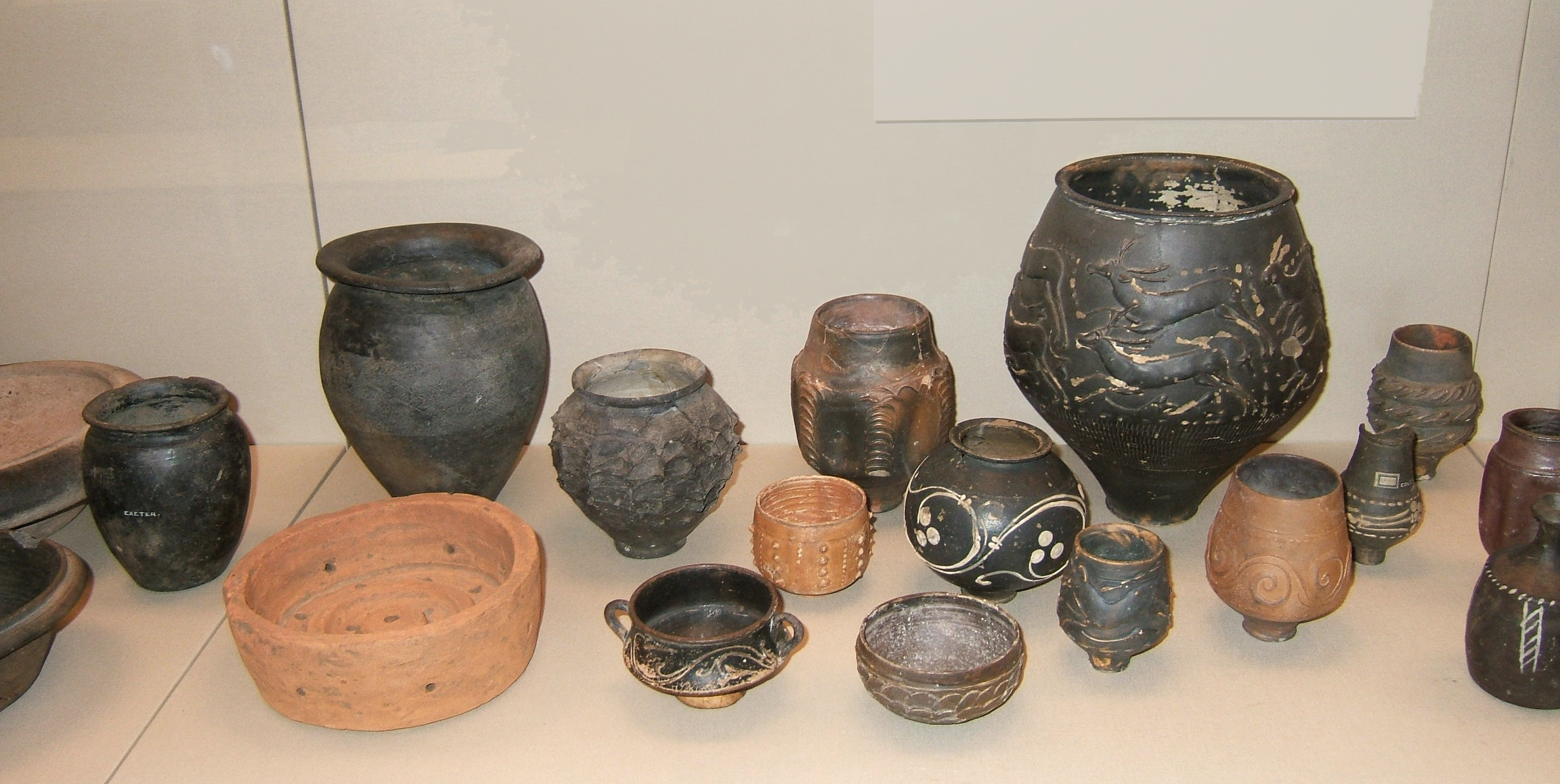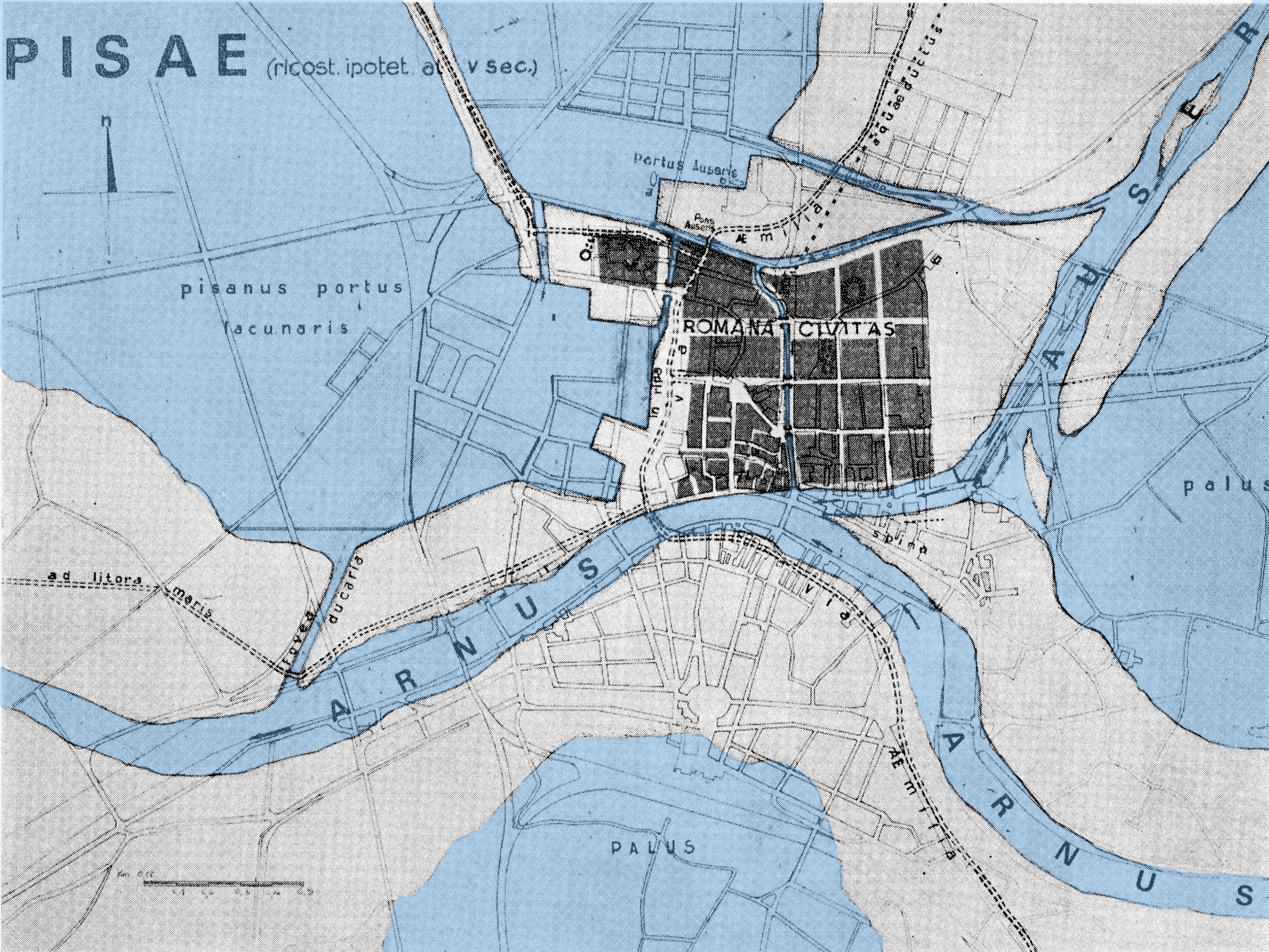|
Ancient Roman Pottery
Pottery was produced in enormous quantities in ancient Rome, mostly for utilitarian purposes. It is found all over the former Roman Empire and beyond. Monte Testaccio is a huge mound, waste mound in Rome made almost entirely of broken amphorae used for transporting and storing liquids and other products – in this case probably mostly Spanish olive oil, which was landed nearby, and was the main fuel for lighting, as well as its use in the kitchen and washing in the Thermae, baths. It is usual to divide Roman domestic pottery broadly into coarse wares and fine wares, the former being the everyday pottery jars, dishes and bowls that were used for cooking or the storage and transport of foods and other goods, and in some cases also as tableware, and which were often made and bought locally. Fine wares were serving vessels or tableware used for more formal dining, and are usually of more decorative and elegant appearance. Some of the most important of these were made at specialised ... [...More Info...] [...Related Items...] OR: [Wikipedia] [Google] [Baidu] |
Terracotta
Terracotta, also known as terra cotta or terra-cotta (; ; ), is a clay-based non-vitreous ceramic OED, "Terracotta""Terracotta" MFA Boston, "Cameo" database fired at relatively low temperatures. It is therefore a term used for earthenware objects of certain types, as set out below. Usage and definitions of the term vary, such as: *In art, pottery, applied art, and craft, "terracotta" is a term often used for red-coloured earthenware sculptures or functional articles such as flower pots, water and waste water pipes, and tableware. *In archaeology and art history, "terracotta" is often used to describe objects such as figurines and loom weights not made on a potter's wheel, with vessels and other objects made on a wheel from the same material referred to as earthenware; the choice of term depends on the type of object rather than the material or shaping technique. *Terracotta is also used to refer to the natural brownish-orange color of most terracotta. *In architecture, ... [...More Info...] [...Related Items...] OR: [Wikipedia] [Google] [Baidu] |
Millau
Millau (; ) is a commune in Occitania, France. Located at the confluence of the Tarn and Dourbie rivers, the town is a subprefecture of the Aveyron department. Millau is known for its Viaduct, glove industry and several nearby natural landmarks such as the Gorges du Tarn. The surrounding Causses are renowned for their pastoral traditions and cheese production, including Roquefort. In this regard, the region has been part of the Causses and Cévennes World Heritage Site since 2011. History The town dates back nearly 3000 years when it was situated on the Granède hills which dominate the town. In the second or first century B.C, it would move to the alluvial plain on the left bank of the Tarn. The plain gave the town its Gallic name of Condatomagus (Contado meaning ''confluence'' and magus for the ''market''). The site of Condatomagus was identified in the 19th century by Dieudonné Rey; it was close to the major earthenware centre in the Roman Empire, La Graufe ... [...More Info...] [...Related Items...] OR: [Wikipedia] [Google] [Baidu] |
La Graufesenque
La Graufesenque is an archaeological site 2 km from Millau, Aveyron, France, at the confluence of the rivers Tarn and Dourbie. As Condatomagus (market of the confluent), it was famous in the Gallo-Roman period for the production of high quality dark red terra sigillata Roman pottery, which was made in vast quantities and exported over much of the western part of the Roman Empire. The site, partly owned by the commune and partly private, has been listed by the French Ministry of Culture since 1926. It was classified as a ''monument historique'' in 1995. History Production of pottery at La Graufesenque started under the reign of Augustus. Production reached a peak in the third quarter of the first century, and declined as a major exporter thereafter. Reduced activity servicing local needs continued until the third century. The pottery was made from local clay with a red slip and fired in wood burning kiln A kiln is a thermally insulated chamber, a type of oven, ... [...More Info...] [...Related Items...] OR: [Wikipedia] [Google] [Baidu] |
Lyon
Lyon (Franco-Provençal: ''Liyon'') is a city in France. It is located at the confluence of the rivers Rhône and Saône, to the northwest of the French Alps, southeast of Paris, north of Marseille, southwest of Geneva, Switzerland, northeast of Saint-Étienne. The City of Lyon is the List of communes in France with over 20,000 inhabitants, third-largest city in France with a population of 522,250 at the Jan. 2021 census within its small municipal territory of , but together with its suburbs and exurbs the Lyon Functional area (France), metropolitan area had a population of 2,308,818 that same year, the second largest in France. Lyon and 58 suburban municipalities have formed since 2015 the Lyon Metropolis, Metropolis of Lyon, a directly elected metropolitan authority now in charge of most urban issues, with a population of 1,424,069 in 2021. Lyon is the Prefectures in France, prefecture of the Auvergne-Rhône-Alpes Regions of France, region and seat of the Departmental co ... [...More Info...] [...Related Items...] OR: [Wikipedia] [Google] [Baidu] |
Pisa
Pisa ( ; ) is a city and ''comune'' (municipality) in Tuscany, Central Italy, straddling the Arno just before it empties into the Ligurian Sea. It is the capital city of the Province of Pisa. Although Pisa is known worldwide for the Leaning Tower of Pisa, the city contains more than twenty other historic churches, several medieval palaces, and bridges across the Arno. Much of the city's architecture was financed from its history as one of the Italian maritime republics. The city is also home to the University of Pisa, which has a history going back to the 12th century, the Scuola Normale Superiore di Pisa, founded by Napoleon in 1810, and its offshoot, the Sant'Anna School of Advanced Studies.Scuola Superiore Sant'Anna di Pisa Information statistics History ...
|
Asia Minor
Anatolia (), also known as Asia Minor, is a peninsula in West Asia that makes up the majority of the land area of Turkey. It is the westernmost protrusion of Asia and is geographically bounded by the Mediterranean Sea to the south, the Aegean Sea to the west, the Turkish Straits to the northwest, and the Black Sea to the north. The eastern and southeastern limits have been expanded either to the entirety of Asiatic Turkey or to an imprecise line from the Black Sea to the Gulf of Alexandretta. Topographically, the Sea of Marmara connects the Black Sea with the Aegean Sea through the Bosporus and the Dardanelles, and separates Anatolia from Thrace in Southeast Europe. During the Neolithic, Anatolia was an early centre for the development of farming after it originated in the adjacent Fertile Crescent. Beginning around 9,000 years ago, there was a major migration of Anatolian Neolithic Farmers into Neolithic Europe, Europe, with their descendants coming to dominate the continent a ... [...More Info...] [...Related Items...] OR: [Wikipedia] [Google] [Baidu] |
Phocaean Red Slip
Phocaean red slip (PRS) is a category of ''terra sigillata'', or "fine" Ancient Roman pottery produced in or near the ancient city of Phokaia in Asia Minor. It is recognizable by its thin reddish Slip (ceramics), slip over a fine fabric, often with occasional white (Lime (material), lime) inclusions. The main period of production is the late 4th century AD into the 7th century, contemporary to the later production of African red slip ware, African red slip. All forms are open bowls or dishes. Later forms have stamped decoration. The most widely used typology was defined by John Hayes in his book ''Late Roman Pottery'', where the ware is called "Late Roman C" according to the name given by Frederick Waagé in his publication of the Antioch excavations. The supplement to that volume established the name "Phocaean Red Slip". Hayes form 3 and Hayes form 10 are the most widely exported forms, appearing in the western Mediterranean and also in the British Isles. Table of Common Forms ... [...More Info...] [...Related Items...] OR: [Wikipedia] [Google] [Baidu] |
Early Muslim Conquests
The early Muslim conquests or early Islamic conquests (), also known as the Arab conquests, were initiated in the 7th century by Muhammad, the founder of Islam. He established the first Islamic state in Medina, Arabian Peninsula, Arabia that expanded rapidly under the Rashidun Caliphate and the Umayyad Caliphate, culminating in Muslim rule being established on three continents (Asia, Africa, and Europe) over the next century. According to historian James Buchan: "In speed and extent, the first Arab conquests were matched only by those of Alexander the Great, and they were more lasting." At their height, the territory that was conquered by the Arab Muslims stretched from Iberian Peninsula, Iberia (at the Pyrenees) in the west to Indian subcontinent, India (at Sind (caliphal province), Sind) in the east; Muslim control spanned Sicily, most of the Middle East and North Africa, and the Caucasus and Central Asia. Among other drastic changes, the early Muslim conquests brought about ... [...More Info...] [...Related Items...] OR: [Wikipedia] [Google] [Baidu] |
African Red Slip
African red slip ware, also African Red Slip or ARS, is a category of '' terra sigillata'', or "fine" Ancient Roman pottery produced from the mid-1st century AD into the 7th century in the province of Africa Proconsularis, specifically that part roughly coinciding with the modern country of Tunisia and the Diocletianic provinces of Byzacena and Zeugitana. It is distinguished by a thick-orange red slip over a slightly granular fabric. Interior surfaces are completely covered, while the exterior can be only partially slipped, particularly on later examples. By the 3rd century AD, African red slip appears on sites throughout the Mediterranean and in the major cities of Roman Europe. It was the most widely distributed representative of the sigillata tradition in the late-Roman period, and occasional imports have been found as far afield as Britain in the 5th-6th centuries. African red slip ware was still widely distributed in the 5th century but after that time the volume of p ... [...More Info...] [...Related Items...] OR: [Wikipedia] [Google] [Baidu] |
Tuscany
Tuscany ( ; ) is a Regions of Italy, region in central Italy with an area of about and a population of 3,660,834 inhabitants as of 2025. The capital city is Florence. Tuscany is known for its landscapes, history, artistic legacy, and its influence on high culture. It is regarded as the birthplace of the Italian Renaissance and of the foundations of the Italian language. The prestige established by the Tuscan dialect's use in literature by Dante Alighieri, Petrarch, Giovanni Boccaccio, Niccolò Machiavelli and Francesco Guicciardini led to its subsequent elaboration as the language of culture throughout Italy. It has been home to many figures influential in the history of art and science, and contains well-known museums such as the Uffizi and the Palazzo Pitti. Tuscany is also known for its wines, including Chianti, Vino Nobile di Montepulciano, Morellino di Scansano, Brunello di Montalcino and white Vernaccia di San Gimignano. Having a strong linguistic and cultural identity, ... [...More Info...] [...Related Items...] OR: [Wikipedia] [Google] [Baidu] |






